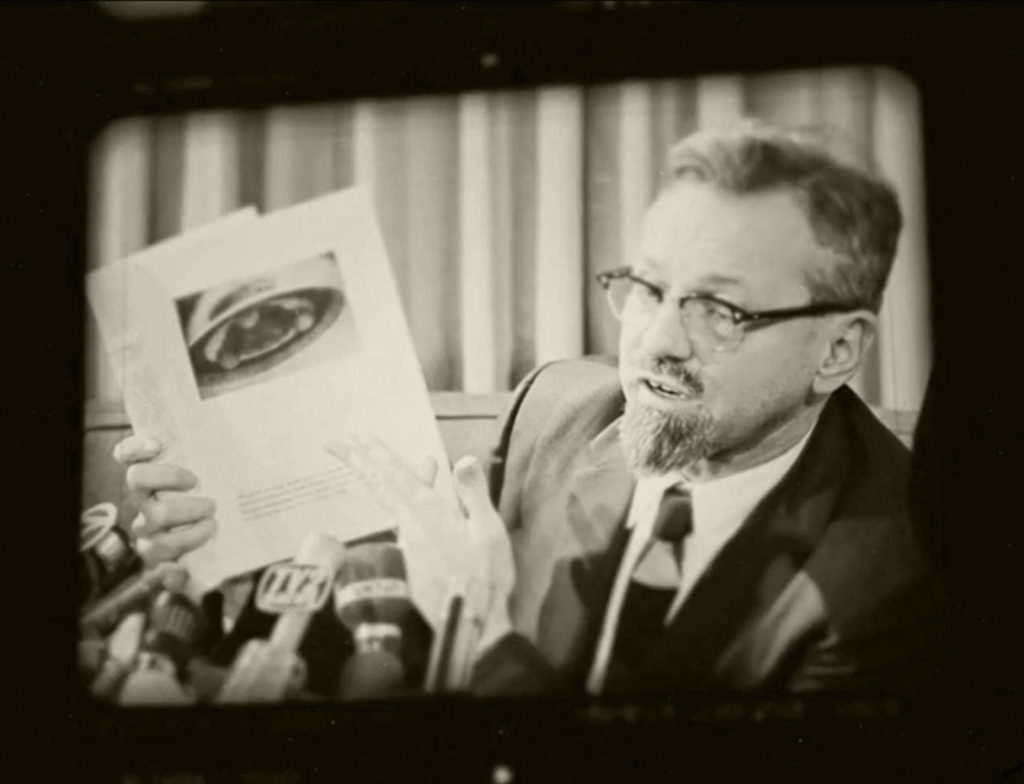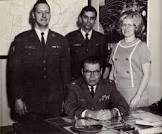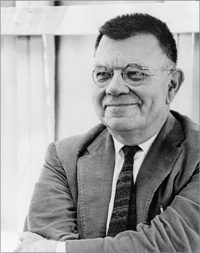by Charles Lear, author of “The Flying Saucer Investigators.”
 In 1966, there was a series of UFO sightings in Michigan that got the attention of the press and the Air Force. There was a great deal of excitement and Project Blue Book (the code name for the Air Force’s UFO study) scientific consultant, Dr. J. Allen Hynek, was sent in to help calm things down. At a press conference, he offered some possible explanations. Due to sightings over a marsh, he speculated that people there had seen ignited balls of swamp gas, some going out and others igniting, and that this created the illusion of movement. The swamp gas explanation made the headlines and outraged many Michigan residents, including Michigan Representative and House Minority Leader Gerald Ford. He sent a letter dated March 28, 1966, to the chairmen of the Science and Astronautics Committee and the Armed Services Committee, suggesting that one of them schedule “hearings on the subject of UFO’s”. He mentioned Hynek’s explanations in the letter and, in a press release that same day, it is noted that he described Hynek’s swamp gas explanation as “flippant.” Documents relating to Ford’s efforts and the resultant open hearing are housed at the Gerald R. Ford Presidential Library and Museum.
In 1966, there was a series of UFO sightings in Michigan that got the attention of the press and the Air Force. There was a great deal of excitement and Project Blue Book (the code name for the Air Force’s UFO study) scientific consultant, Dr. J. Allen Hynek, was sent in to help calm things down. At a press conference, he offered some possible explanations. Due to sightings over a marsh, he speculated that people there had seen ignited balls of swamp gas, some going out and others igniting, and that this created the illusion of movement. The swamp gas explanation made the headlines and outraged many Michigan residents, including Michigan Representative and House Minority Leader Gerald Ford. He sent a letter dated March 28, 1966, to the chairmen of the Science and Astronautics Committee and the Armed Services Committee, suggesting that one of them schedule “hearings on the subject of UFO’s”. He mentioned Hynek’s explanations in the letter and, in a press release that same day, it is noted that he described Hynek’s swamp gas explanation as “flippant.” Documents relating to Ford’s efforts and the resultant open hearing are housed at the Gerald R. Ford Presidential Library and Museum.
The Armed Services Committee held an open hearing on April 5, 1966. There to answer questions were Secretary of the Air Force Harold Brown, Director of Project Blue Book  , and Hynek. When the session was opened to the press and public, the first person to answer questions from the committee chairman, L. Mendel Rivers, was Harold Brown. Brown’s answers reflected a belief that most sightings could be explained in prosaic terms and that any remaining unidentifieds were due to lack of information.
, and Hynek. When the session was opened to the press and public, the first person to answer questions from the committee chairman, L. Mendel Rivers, was Harold Brown. Brown’s answers reflected a belief that most sightings could be explained in prosaic terms and that any remaining unidentifieds were due to lack of information.
Hynek was next and he started by stating that he was treated “rather unfairly” by the press. Brown responded, “You ought to be chairman of this committee.” Hynek then added that he was described by the press as “a puppet of the Air Force.” In response, he had prepared a written statement and he was allowed to read it. Hynek declared that he had “attempted to remain open minded” throughout his involvement “despite the fact that the whole subject seemed utterly ridiculous.” He mentioned that he’d recommended in 1953 and 1965 that a “small civilian scientific panel” be used to study “selected unknowns.” Hynek then told Rivers that he’d been “scooped” by Brown, who’d mentioned that the Scientific Advisory Board (a group put together to review Project Blue Book who released their report in March, 1966) had recommended the same. Now under pressure from Congress and the public, the Air Force was moved to act on that recommendation.
The “civilian scientific panel” would turn out to be a group put together at the University of Colorado, led by Dr. Edward U. Condon. This would become known as the “Condon committee” and evidence of negative bias on the part of Condon and the project’s coordinator, Robert Low, prompted another discussion of UFOs in Congress.

Some representatives felt there was a need to evaluate the Colorado study after public comments made by Condon to the effect that UFOs were “nonsense.” For some time the National Investigations Committee on Aerial Phenomena led by Maj. Donald Keyhoe (ret.) had been lobbying Congress for hearings on the Air Force’s handling of the UFO problem and had managed to gain supporters. One of those was Rep. Louis C. Wyman of New Hampshire.
On October 17, 1967, Wyman introduced House Resolution 946. It called for the Committee on Science and Astronautics to “conduct a full and complete investigation and study of unidentified flying objects.” In a House floor speech to gain support for his resolution, Wyman referred to NICAP and “UFO Evidence,” a publication NICAP had prepared and sent to every member of Congress, in an effort to show that the UFO subject should be taken seriously.
Rep. J. Edward Roush of Indiana was sympathetic with Wyman’s views, but he thought the action called for by the resolution was premature, as the results of the Colorado study hadn’t been released. Roush proposed a symposium instead, and through his efforts, one was arranged where six scientists would present their views on the subject before the Committee on Astronautics.
The “Symposium on Unidentified Flying Objects” was held on July 29, 1968. Among the scientists invited to speak were Hynek, atmospheric physicist Dr. James McDonald, and noted astronomer Dr. Carl Sagan. Other scientists, including Dr. Donald H. Menzel, Dr. R. Leo Sprinkle, and Stanton T. Friedman, submitted written statements. Friedman, whose place of employment is listed as the Westinghouse Astronuclear Laboratory, would later become a well-known UFO lecturer and achieve celebrity status in the field.
Hynek was first to speak and during the majority of his statement he made the case for scientific UFO study with international cooperation. He ended by recommending that Congress establish a UFO Scientific Board of Inquiry.
McDonald was up next. McDonald had become interested in UFOs after investigating sightings in his home state of Arizona and was one of the first scientists willing to publicly come forward and advocate for the serious study of UFOs. McDonald briefly summarized the UFO problem and then gave details of individual cases and his investigations of some of them. He concluded his summary by stating that the possibility that UFOs are extraterrestrial devices “is a possibility I take very seriously.” He concurred with Hynek’s view that a worldwide on-going scientific study was called for and urged the committee to hold more extensive hearings on the subject of UFOs.
Dr. Carl Sagan spoke next. He said that it was his understanding that the committee wanted him to discuss the possibility of “intelligent extraterrestrial life.” He told the committee that he was “delighted” to speak about the “contemporary scientific thinking along these lines.” He let it be known that it was his belief that the evidence of intelligent extraterrestrial origin for UFOs was not “persuasive” but evidence that no UFOs are of that origin was not “convincing.” He felt the question was an “open one.”
After a slide presentation where he showed the limits of our optical technology to detect civilizations on other planets and provided a sense of perspective on our position in the universe, Sagan took questions. He was asked about electrical pulses detected by Sir Bernard Lovell that Lovell couldn’t explain and Sagan replied that these were from objects called “pulsars.” He said that while there were problems with the hypotheses presented to explain them, one should exclude all “physical explanations” before concluding that some “intelligent being” was involved.
Sagan began his conclusion by pointing out that the scientific method calls for keeping an open mind while pursuing the facts at hand. With that said, he brought attention to the fact that there were none on the panel “who strongly disbelieve in the extraterrestrial origin of UFOs.” As far as recommending funds for UFO study, he felt that money was better spent on the programs of NASA and the National Science Foundation radio astronomy programs.
The symposium failed to sway Congress to allocate funding for UFO research. Project Blue Book was terminated in 1969 and that was the end of government funded UFO research for many years until recently.
(Note: this is a previous post on this website years ago, before it was hacked)